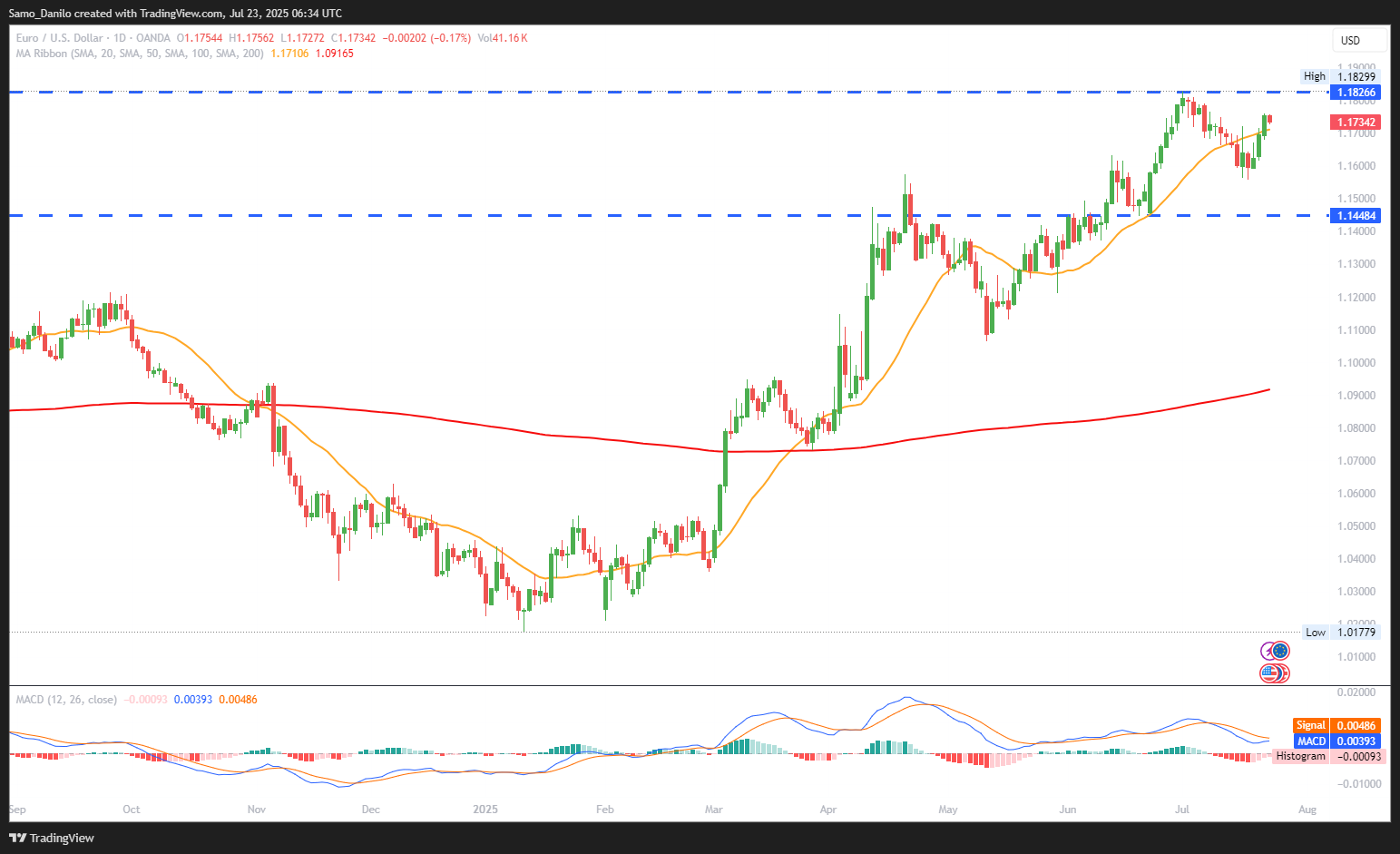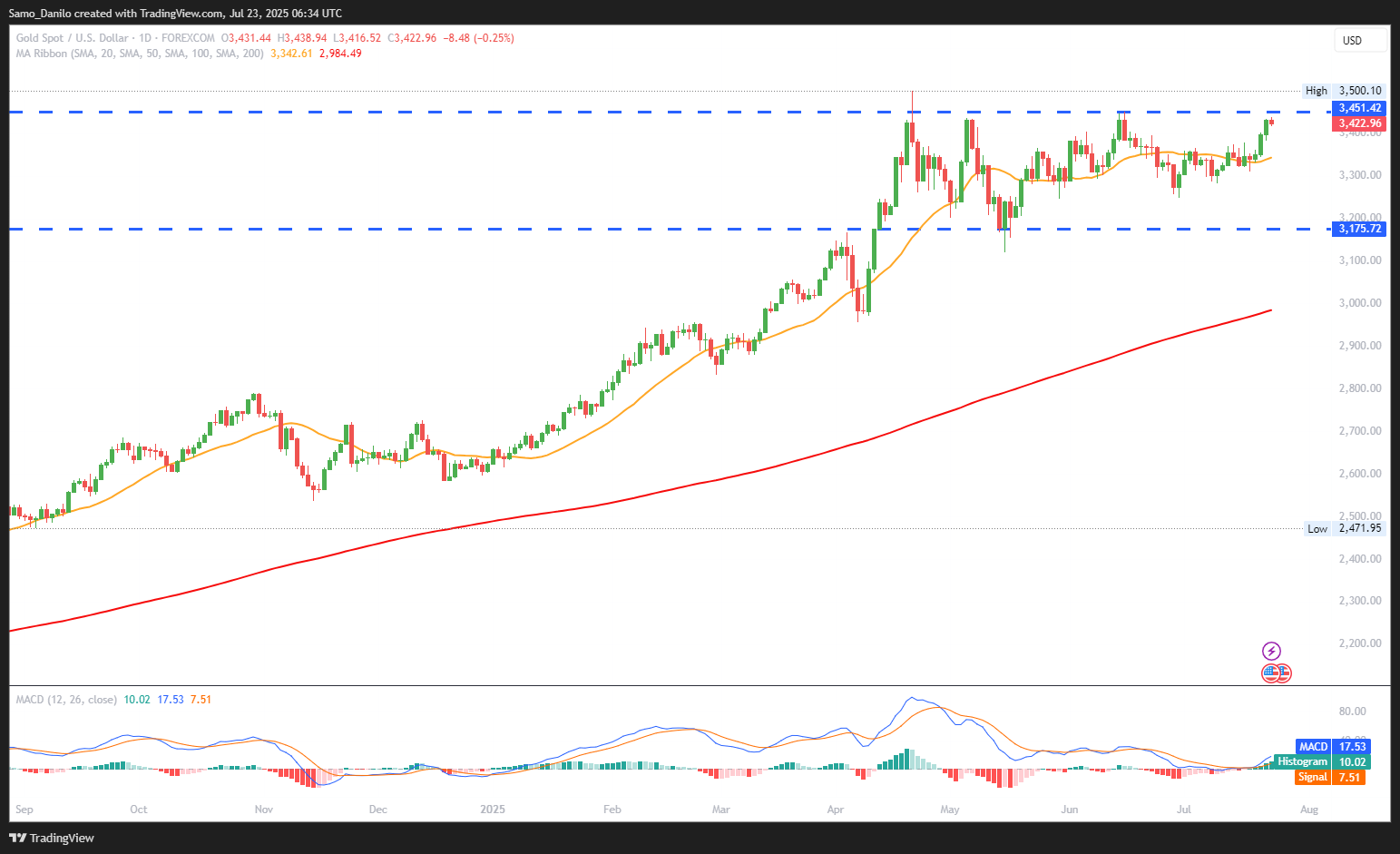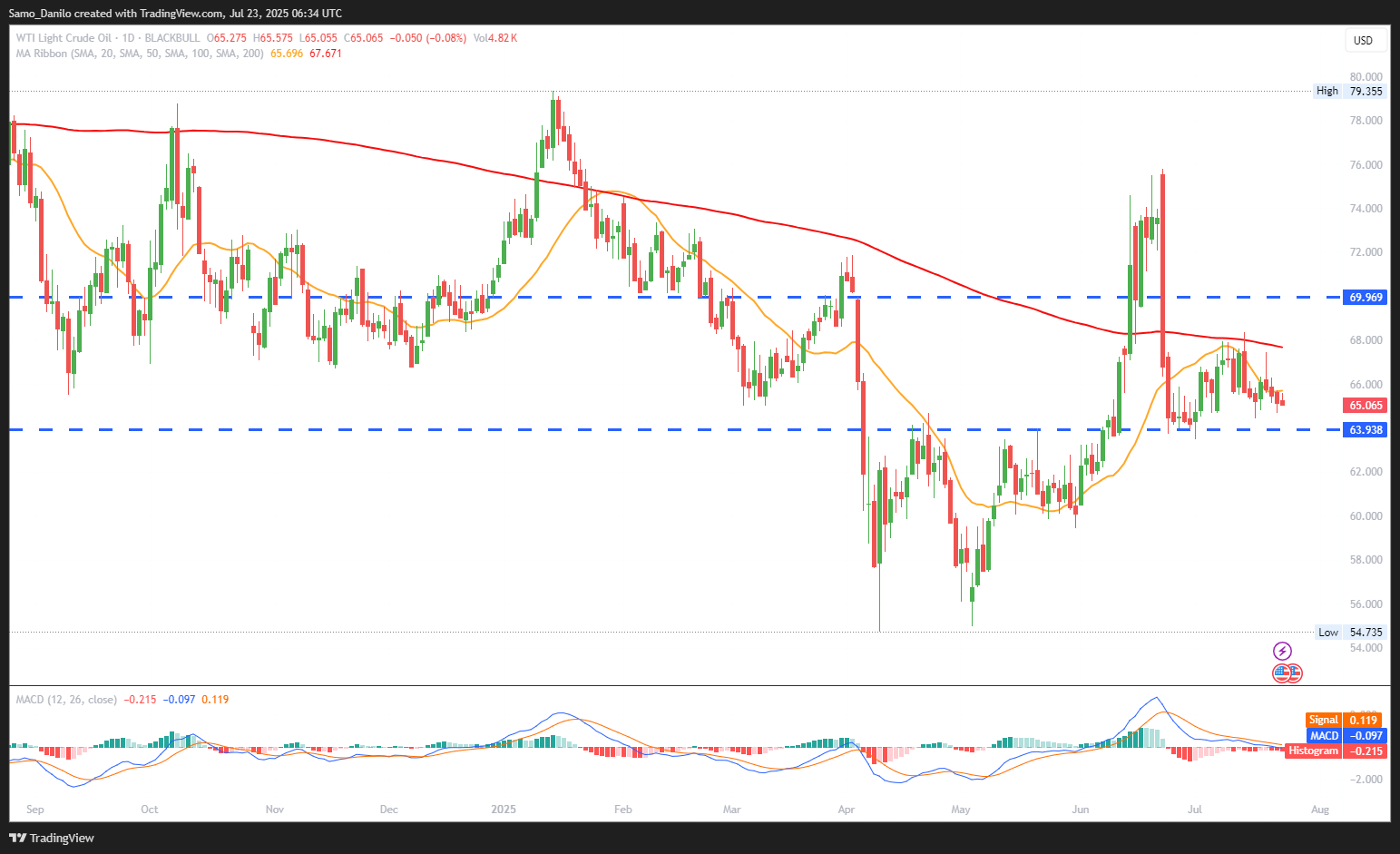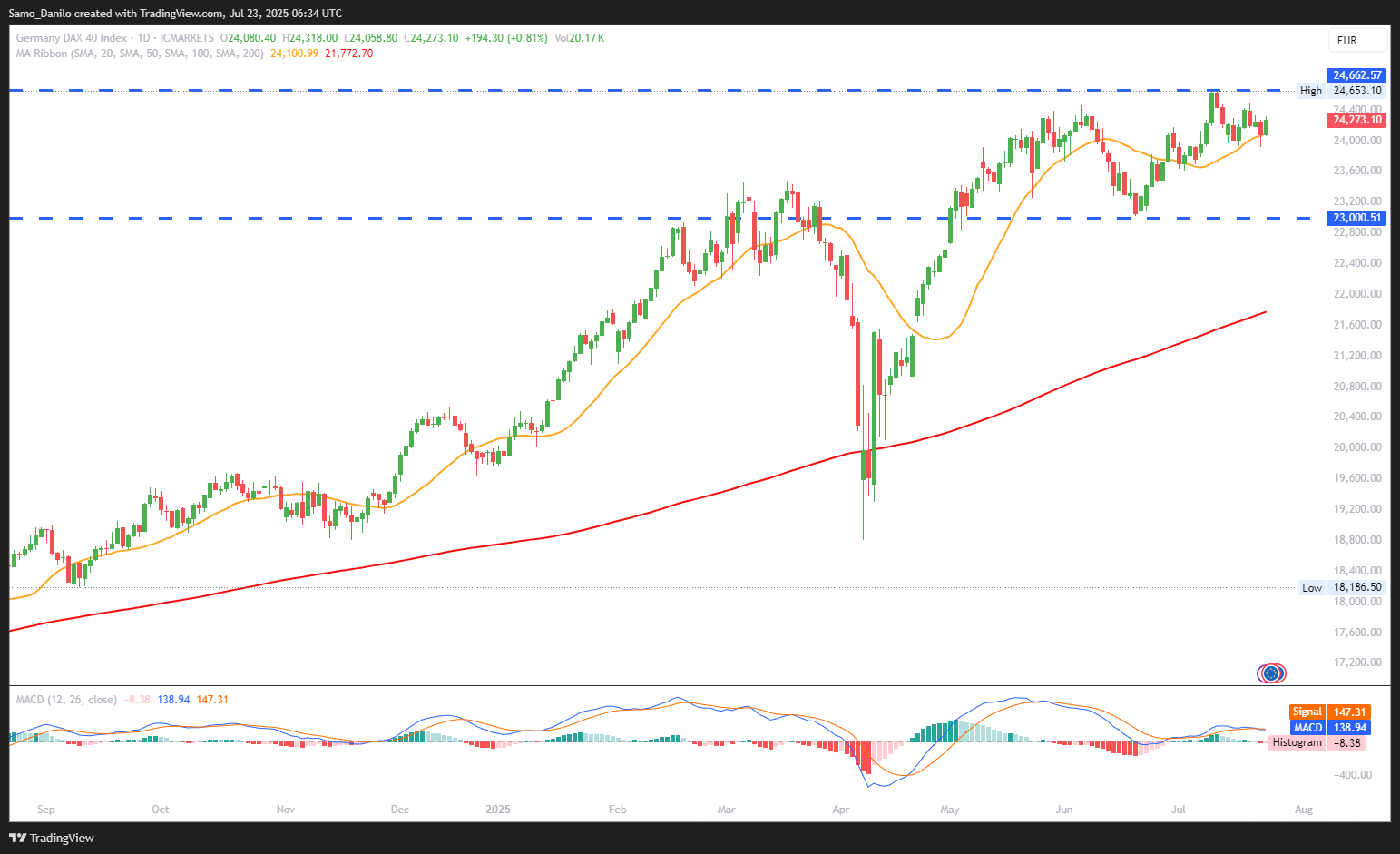EURUSD
- EUR/USD Price: The EUR/USD pair advanced to a two-week peak around 1.1760 on Tuesday before retreating slightly to 1.1730 on Wednesday, reflecting a pause in bullish momentum as investors monitor key policy and trade developments.
- EU–US Trade: Trade talks between EU and US officials are underway virtually, with no confirmed in-person meetings between senior representatives. The absence of high-level engagement adds uncertainty to the process, especially with tariffs looming.
- Retaliatory Tariffs: In response to Trump’s proposed 30% tariff on EU imports, Brussels is preparing retaliatory tariffs on US digital services, aerospace products, and bourbon. However, these measures would likely have limited offsetting impact due to the imbalance in trade exposure.
- ECB Rates: The upcoming ECB meeting on Thursday presents event risk for the Euro. While a rate hold is expected, the focus will be on the Monetary Policy Statement and Lagarde’s press conference, particularly regarding inflation outlook and potential easing later in the year.
- Data Calendar: On the data front, markets await MBA Mortgage Applications and Existing Home Sales in the US. In the Eurozone, the preliminary Consumer Confidence reading is the key economic release, potentially offering insight into regional sentiment amid inflation and trade uncertainty.
Closing statement: EUR/USD remains supported near recent highs, but the path forward hinges on the outcome of EU–US trade negotiations and the ECB's tone at Thursday’s meeting. While no major moves are imminent, rhetoric and policy signals could steer direction as markets brace for macro and geopolitical catalysts.
GBPUSD
- GBP/USD Price: The GBP/USD pair broke above the 1.3500 mark on Tuesday, reaching multi-day highs as US Dollar weakness accelerated. By Wednesday, the pair edged slightly lower, trading at 1.3520, holding most of its recent gains.
- UK Borrowing: UK public sector net borrowing came in at £20.7 billion in June, well above the £17.1 billion forecast by the Office for Budget Responsibility. This shortfall raised fiscal sustainability concerns and potential implications for future tax policy.
- Tax Hikes: The borrowing data has increased speculation that Chancellor Rachel Reeves may be forced to raise taxes in the Autumn budget to stabilize public finances. This introduces domestic policy uncertainty, which could weigh on sentiment.
- BoE’s Bailey: Bank of England Governor Andrew Bailey addressed the fiscal outlook’s influence on bond markets, noting curve steepening. The market continues to price in a 25bp rate cut by August, with 50bp of easing expected by year-end, showing cautious dovishness.
- Key Data: Traders are now looking ahead to S&P Global Flash PMIs for July in the UK for a pulse on business activity. Meanwhile, US data releases include Initial Jobless Claims, housing data, and durable goods orders, all of which could impact GBP/USD direction.
Closing statement: GBP/USD remains resilient above 1.3500 as dollar weakness dominates, but rising concerns over UK fiscal health and potential tax increases could limit upside. Attention now turns to PMI data and central bank commentary for further directional cues.
XAUUSD
- XAU/USD Price: Gold extended its bullish momentum on Tuesday, surging past the $3,400 level to reach new five-week highs, and is now consolidating around $3,420 on Wednesday. The move reflects ongoing demand for safe haven assets, despite some headwinds.
- Fed Independence: US Treasury Secretary Scott Bessent raised concerns over the Federal Reserve’s effectiveness, suggesting it may be time to reassess the institution. These remarks, aired on CNBC, have fueled policy uncertainty, which historically benefits non-yielding assets like Gold.
- Trump's Criticism: In a public setting with Philippine President Ferdinand Marcos, President Trump criticized Fed Chair Jerome Powell, hinting at his potential dismissal. This has raised market unease, increasing the appeal of traditional safe havens like Gold amid perceived institutional instability.
- Bitcoin's Rise: While geopolitical and policy risk typically drive Gold higher, recent institutional inflows into Bitcoin, driven by regulatory improvements, have diverted part of the risk-off capital that might otherwise flow into Gold, moderating its rally.
- Fed Blackout: The Federal Reserve is in blackout mode ahead of its July 30 interest rate decision, meaning no official commentary is expected until then. This keeps markets in a holding pattern, with Gold likely to react sharply to any post-meeting guidance.
Closing statement: Gold remains buoyed by institutional uncertainty and Fed-related tensions, but upside may be capped in the short term due to competition from digital assets and a lack of fresh policy signals. Traders await the July 30 Fed decision for the next directional cue.
CRUDE OIL
- Crude Oil Price: West Texas Intermediate (WTI) is trading around $65.00 during early European hours on Wednesday, struggling for clear direction. Traders are balancing demand-side fears against supportive inventory data, keeping prices range-bound.
- Tariff Concerns: Renewed tariff threats from President Trump have intensified worries about slower global economic growth, particularly in Asia and Europe. This sentiment is putting downward pressure on crude prices as investors reassess future energy demand.
- Resumption of Export: The Iraqi government’s decision to resume crude exports from the Kurdistan Region after a two-year pause is adding to oversupply concerns. This move could significantly increase global oil output, contributing to market bearishness.
- API Report: The American Petroleum Institute (API) reported a 577,000-barrel decline in US crude oil inventories for the week ending July 18, partially offsetting last week’s massive 19.1 million barrel surge. This modest draw could offer short-term support for WTI.
- EIA Inventory: Markets are now awaiting the US Energy Information Administration (EIA) weekly inventory report due later on Wednesday. Confirmation of the API’s draw could help stabilize prices, while a surprise build could trigger renewed selling.
Closing statement: Crude oil remains under pressure from macroeconomic and oversupply concerns, but supportive inventory data could limit losses in the near term. Traders will closely watch the EIA report for further clarity on market direction.
DAX
- DAX Price: The DAX fell 1.09% on Tuesday, July 22, erasing Monday’s minor gain and closing at 24,042. The sharp decline reflected rising geopolitical tensions, particularly surrounding US-EU trade relations, which weighed heavily on investor sentiment.
- US-EU Trade: Investor confidence was dented by reports of a stalemate in trade talks ahead of Trump’s August 1 tariff deadline. Fears escalated as the EU began preparing retaliatory measures against a proposed 30% US levy on EU goods, raising the specter of a full-blown transatlantic trade war.
- Index Stocks: The export-heavy DAX index was particularly vulnerable to these trade risks. Technology stocks led the losses, with Infineon Technologies down 3.51% and SAP falling 1.5%. The automotive sector also suffered: BMW lost 1.49%, Mercedes-Benz dropped 1.05%, and Volkswagen slipped 0.92%.
- Consumer Confidence: Attention now turns to Eurozone Consumer Confidence data scheduled for release on Wednesday, July 23. Markets are expecting a slight improvement from -15.3 to -15.0, but any downside surprise could add to the bearish mood.
- Japan-US Trade: Overnight news of a US-Japan trade agreement offered a small reprieve. Japan accepted a 15% tariff and pledged $550 billion in investments in exchange for a favorable profit-sharing clause. This raises hopes that the EU might still avoid steep US tariffs through similar concessions.
Closing statement: The DAX remains under pressure from rising global trade tensions, with sentiment likely to remain fragile until clarity emerges on the US-EU tariff front. Economic data and political developments over the next few days will be key to near-term direction.





